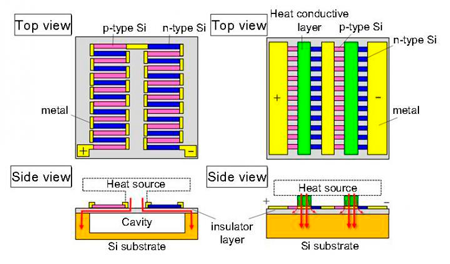 A silicon-nanowire thermoelectric generator has been developed by a team of researchers from Waseda University, Osaka University, and Shizuoka University.
A silicon-nanowire thermoelectric generator has been developed by a team of researchers from Waseda University, Osaka University, and Shizuoka University. A silicon-nanowire thermoelectric generator has been developed by a team of researchers from Waseda University, Osaka University, and Shizuoka University.
A silicon-nanowire thermoelectric generator has been developed by a team of researchers from Waseda University, Osaka University, and Shizuoka University.
According to the Japanese researchers, this experimentally demonstrated a high-power density of 12 microwatts per 1cm2, enough to drive sensors or realise intermittent wireless communication, at a small thermal difference of only 5ºC.
Silicon-based thermoelectric generators conventionally employed long, silicon nanowires of about 10-100nm, which were suspended on a cavity to cut off the bypass of the heat current and secure the temperature difference across the silicon nanowires. However, the cavity structure weakened the mechanical strength of the devices and increased the fabrication cost. The team says their generator has overcome this issue.
"Because our generator uses the same technology to manufacture semiconductor integrated circuits, its processing cost could be largely cut through mass production," says Professor Takanobu Watanabe of Waseda University. “Also, it could open up a pathway to various, autonomously-driven IoT devices utilising environmental and body heats. For instance, it may be possible to charge your smartwatch during your morning jog someday."
The researchers say their thermoelectric generator lost the cavity structure but instead shortened the silicon nanowires to 0.25nm, since simulations showed that the thermoelectric performance improved by minimising the device.

Conventional thermoelectric generator (left) and newly developed thermoelectric generator (right). Credit: Waseda University
Prof Watanabe explains that despite its new structure, the thermoelectric generator demonstrated the same power density as the conventional devices. He adds that the thermal resistance was suppressed, and the power density multiplied by ten times by thinning the generator's silicon substrate from the conventional 750nm to 50nm with backside grinding.
Though the research team will need to improve the quality of the generator for stationary power generation in various conditions, Prof Watanabe hopes that the results achieved in this study will serve to support power technology in the IoT-based society.
Author
Bethan Grylls
Source: www.newelectronics.co.uk